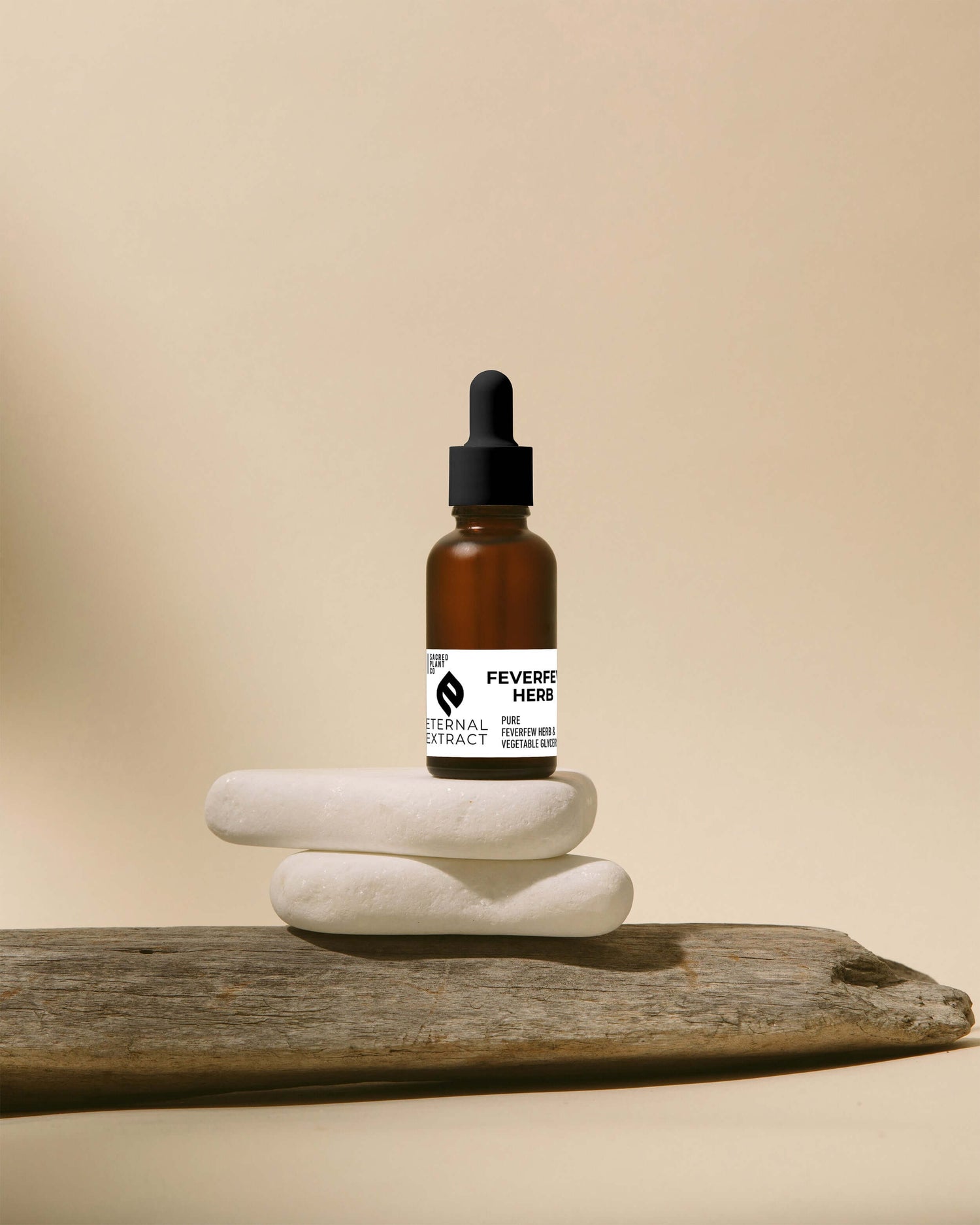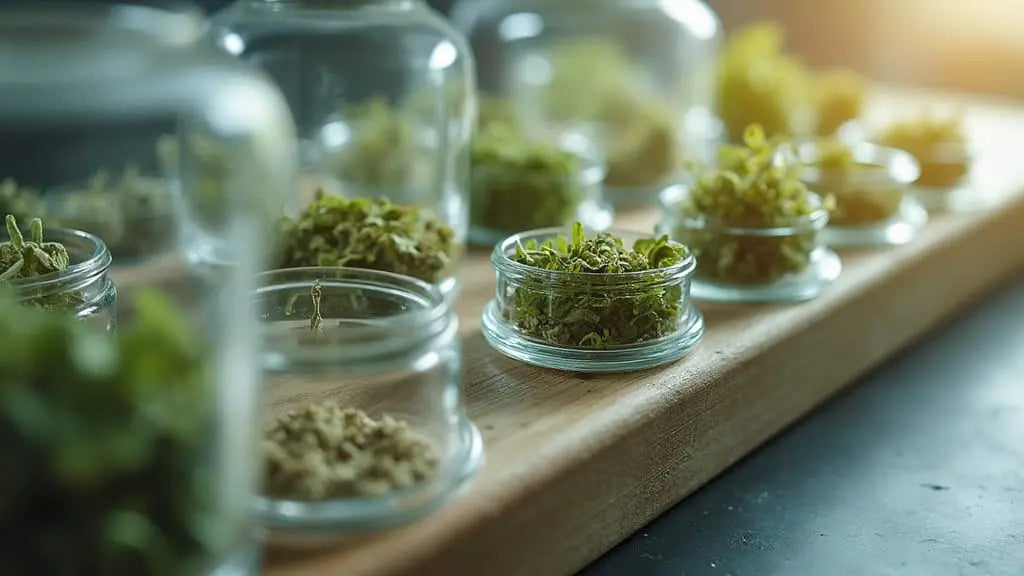Feverfew vs Willow for Headaches: Evidence, Safety, and How to Choose
Short answer: Feverfew is best positioned for migraine prevention using standardized extracts taken daily over several weeks, with the strongest signals seen when a stable extract is used consistently (Cochrane 2015). White willow bark is a short‑term analgesic for adult headache patterns that resemble tension‑type pain because its salicin converts to salicylic acid. It carries important exclusions for children, pregnancy, lactation, aspirin sensitivity, bleeding risk, and anticoagulant therapy (EMA Salicis cortex, USP 2019 safety review).
Sacred Plant Co offers both tinctures and bulk herb teas for these classics, so the guide below explains when each form makes sense, how to use them safely, and what to expect. For deeper background, see feverfew, white willow bark, and herbal pain relief tea basics.
How they work
Feverfew (Tanacetum parthenium)
Feverfew contains sesquiterpene lactones, especially parthenolide, that interact with pathways tied to migraine initiation and sensitization. Evidence includes effects on TRPA1‑mediated trigeminovascular signaling and on platelet activity in translational models. These mechanisms support preventive use rather than immediate pain relief (TRPA1 review, platelet study). Clinical results across decades have been mixed, but standardization and stability of the extract appear to matter (Cochrane 2015).
White willow bark (Salix spp.)
Willow bark supplies salicin and related phenolics. After absorption, salicin is metabolized to salicylic acid. This pharmacology supports short‑term use in adult pain states, with traditional use recognition for headache in Europe (EMA). Because it behaves like a salicylate, willow shares safety boundaries with aspirin (see “Willow bark safety”).
Evidence at a glance
| Criteria | Feverfew | White willow bark |
|---|---|---|
| Best fit | Preventive strategy for recurrent migraine. Evaluate after several weeks of a stable, standardized extract. | Short‑term analgesia for adult tension‑type headache patterns. Not a first‑line acute migraine abortive. |
| Human evidence snapshot | A large, rigorous trial of a stable feverfew extract reduced monthly migraine frequency versus placebo. Earlier trials were inconsistent. Professional summaries list standardized feverfew such as MIG 99 as probably effective for prevention (Cochrane full text). | EMA recognizes willow bark as a traditional herbal medicine for headache in adults. Randomized data are stronger in musculoskeletal pain; the headache indication reflects longstanding use with safety guardrails (EMA, USP 2019). |
| Onset and trial window | Gradual. Plan 4 to 8 weeks of daily use before judging effect (Cochrane). | Label‑directed acute use. Seek care if headache persists or worsens (EMA). |
| Preferred form (evidence) | Standardized extract with defined parthenolide‑related content. Whole leaf can vary in potency. | Standardized extract labeled for salicin content. Adult‑only for headache. |
| Key cautions | Avoid in pregnancy and while nursing. Possible mouth irritation with raw leaves. Discuss antiplatelet or anticoagulant therapy with a clinician (NCCIH). | Avoid in children and teens, pregnancy, lactation, aspirin allergy, bleeding disorders, and with anticoagulants. Use short courses only (USP 2019). |
Feverfew in practice
Regenerative cultivation and consistency. Sacred Plant Co’s feverfew program focuses on soil health, biodiversity, and careful harvest timing. The goal is consistent, potent material that behaves predictably in finished extracts and teas. Consistency matters because variability in parthenolide content has been one driver of mixed outcomes in older studies (Cochrane 2015).
How to use feverfew — tincture vs tea
- Tincture: follow label directions and keep the dose and timing the same every day. Preventive strategies are built on consistency, not on‑demand use (Cochrane).
- Tea: many migraine‑focused protocols prefer standardized tinctures or capsules for precision. If using tea, brew 1 to 2 teaspoons dried herb in 8 ounces hot water for 10 minutes, covered. Evaluate tolerance and consider switching to a standardized form for steady prevention.
- Trial window: record monthly migraine days and rescue use. Evaluate at 4 to 8 weeks.
Feverfew safety
- Pregnancy and lactation: avoid unless a clinician specifically advises otherwise (NCCIH).
- Mouth irritation: avoid chewing fresh leaves. Capsules or liquids reduce this issue (NCCIH).
- Medications: discuss feverfew with a clinician if taking anticoagulants or antiplatelets, or before procedures (NCCIH).
- Stop rules: discontinue for mouth ulcers, unusual bruising or bleeding, or any concerning new symptom.
White willow bark in practice
Willow bark’s salicin‑to‑salicylic acid pathway explains both its potential to relieve short‑term pain and its safety overlap with aspirin. EMA recognizes adult use for headache within a traditional‑use framework, which emphasizes brief duration and medical follow‑up if symptoms persist or worsen (EMA HMPC).
How to use willow — tincture vs tea
- Tincture: follow the labeled adult dose. Do not combine with aspirin or other salicylates without clinician guidance (USP 2019).
- Tea — simple decoction: 1 to 2 teaspoons cut bark in 8 to 10 ounces water. Simmer gently for 10 to 15 minutes, covered. Strain and sip. Tea is traditional and soothing, though salicin delivery can be more consistent with standardized extracts.
- Duration: short courses only. Seek care if headache persists, intensifies, or presents with red‑flag symptoms.
30‑second chooser
- Prevention focus with a migraine pattern — consider a standardized feverfew tincture trial. Use daily for 4 to 8 weeks while tracking monthly migraine days and rescue use.
- Short‑term relief for tension‑type headache and no salicylate exclusions — consider a labeled willow bark tincture or a simple decoction, used briefly.
- Any red flags such as new severe headache, neurological change, high fever, post‑trauma, or sudden worst headache — seek medical care first.
How to try them safely — step‑by‑step protocol
- Start a headache journal. Track date, hours slept, hydration, caffeine, triggers, pain location, intensity, associated symptoms, and any medications or herbs used. This reveals patterns and informs decisions.
- Choose one herb and one form to start. For prevention, pick a standardized feverfew tincture and dose at the same time daily. For short‑term relief, choose willow bark tincture or tea. Do not combine initially so results are clear.
- Set the trial window. Feverfew: evaluate at 4 to 8 weeks for changes in monthly migraine days and rescue use. Willow: evaluate response per dose over a brief course and assess whether it reduces the need for other analgesics.
- Avoid conflicts. With willow, do not layer aspirin or other salicylates without clinician guidance. With feverfew, avoid chewing fresh leaves and watch for mouth irritation.
- Apply stop rules and seek care when needed. For feverfew: mouth ulcers or unusual bleeding. For willow: bleeding, black or tarry stools, persistent GI pain, or allergic symptoms.
History and cultural roots
Feverfew has long been used in European folk practice for head pain and women’s health. White willow bark is a foundation of European traditional medicine and inspired the rise of salicylate medicines in the late nineteenth century. Modern practice weaves this history into standardized extracts, clear labeling, and strict safety boundaries so readers can use these botanicals wisely (EMA).
Frequently asked questions
Is feverfew for prevention or for stopping a headache once it starts?
Feverfew is positioned for prevention. Signals come from weeks of steady use with standardized extracts, not from on‑demand dosing at headache onset (Cochrane).
How long until feverfew might help?
Evaluate after 4 to 8 weeks of consistent daily use while tracking monthly migraine days and rescue medicine use (Cochrane).
What is MIG 99?
MIG 99 is a standardized feverfew extract studied for migraine prevention and referenced in professional summaries as probably effective. Standardization and stability were central to its design (Cochrane overview).
Is willow bark similar to aspirin?
Willow contains salicin that the body converts to salicylic acid, which explains both potential benefits and salicylate‑like cautions (USP 2019; EMA).
Who should not use willow bark?
Children and teens, people who are pregnant or nursing, individuals with aspirin allergy or bleeding risk, and anyone on anticoagulants should avoid willow bark unless a clinician directs otherwise (USP 2019).
Can feverfew and willow be combined?
Begin with single‑herb trials so benefits and any side effects are easy to interpret. Combination strategies should be clinician‑guided, especially when other medications are used.
What salicin amounts are typical in adult trials of willow bark?
Common adult standardizations in musculoskeletal pain studies ranged roughly 120 to 240 mg salicin daily over several weeks. For headache, follow the labeled adult dose and short‑course guidance (USP 2019 review).
Related Sacred Plant Co resources
Feverfew deep dive • White willow overview • Herbs and spices collection • Pain relief tea
Medical disclaimer
This article is for educational purposes only and is not medical advice. Products and methods described are not intended to diagnose, treat, cure, or prevent any disease. Always consult a qualified healthcare professional before using herbs, especially if you are pregnant, nursing, taking medications, have a bleeding risk, or have a medical condition.
Sources
- Cochrane Review: Feverfew for preventing migraine (2015)
- Cochrane Library full text (2015)
- Parthenolide, TRPA1, and migraine pathways (review)
- Parthenolide and platelet function
- NCCIH: Headaches and complementary approaches
- EMA HMPC: Salicis cortex (willow bark) monograph summary
- United States Pharmacopeia safety review: willow bark (2019)









